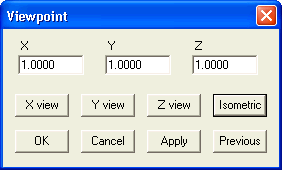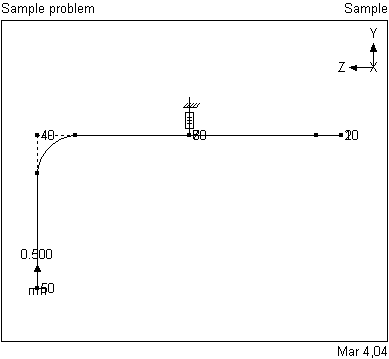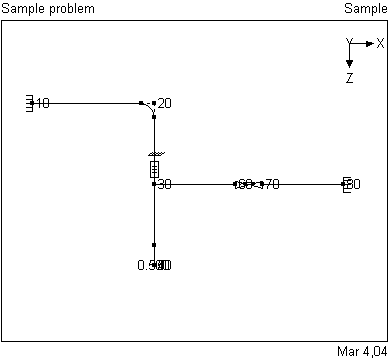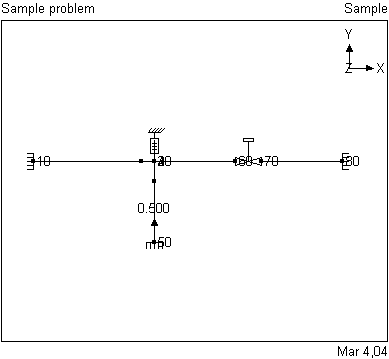Software Solutions
- CAEPIPE
- CAEPIPE 3D+
- checkSTRESS
- dataTRANSLATORS
- HOTclash
- PEXit
- Pricing Request
- Download Free Evaluation
- Download CAEPIPE 3D+
- Download Free Review Module
- Customer Support
Engineering Services
- Design and Engineering
- INFOplant™ System
- Engineering Management
- List of Projects
- Project Gallery
- Project Videos
Learn More
Company Information
Tips January - March 2004
Static Seismic Loadcase – Notes
Sometimes users are surprised to learn that CAEPIPE does not include the weight of the piping system in Seismic loadcase. A few reasons exist for doing so. 1. The weight is already included in Sustained loadcase, and 2. Piping codes such as B31.3 specifically mention that MA and MB calculations be done separately before combining them to calculate SO (Occasional stress).
As weight is not considered in seismic (or purely wind or thermal cases), there is little use in considering the status of the limit stops - because no weight means no friction load, and as a result, no limit stop load. If you are thinking how the g-load is applied, then the answer is that CAEPIPE applies x% (0.6g, x=60%) of the system weight as a force in the specified direction.
If you can, avoid non-linearities such as gaps and friction when you model seismic loads. As it is, Static Seismic is an approximation of Response Sepctrum which is an approximation of Time History analysis! So, the result you get is already an approximation.
Anyway, once you get the results from a seismic case, you can add these loads to those from Sustained to find the combination loads. Simply look under the Support load summary to get the support loads for the full range Sustained+Seismic to Sustained-Seismic.
Natural Frequencies and Nonlinearities in CAEPIPE
If you take the model as shown below and analyze it twice, by "excluding friction in dynamic analysis" (see menu Options>Dynamics) the first time and "including friction in dynamic analysis" the second time, you will see two different sets of natural frequencies.
With "exclude friction in dynamic analysis," the frequencies are (Run 1):
f1 = 12.118 Hz, f2 = 15.529 Hz, f3 = 21.939 Hz, f4 = 22.999 Hz, f5 = 44.918 Hz
With "include friction in dynamic analysis," the frequencies are (Run 2):
f1 = 15.320 Hz, f2 = 20.295 Hz, f3 = 24.548 Hz, f4 = 25.182 Hz, f5 = 44.930 Hz
You might wonder why this is so? The natural frequencies for a system should have been the same regardless. That would have been true except that, here, there is a wild card – a nonlinearity, i.e., a limit stop. Why is this a wild card? Because the status of the limit stop at the end of the Operating loadcase (W+P1+T1) will determine whether or not the global stiffness matrix [K], which is used for modal analysis, is affected. In other words, because this limit stop is active (i.e., the limit is reached), the friction in the limit stop, through "equivalent stiffnesses," is included in the global stiffness matrix [K] before performing modal analysis. Consequently, frequency, which is proportional to square root ([K]/[M]), will be higher due to the higher stiffness. [M] is the mass matrix.
Note that if you do not input a friction for the limit stop, owing to this model's configuration, you will see the same frequencies for run 2 as in run 1. Also, theoretically, it is possible that the frequencies might be unaffected by limit stop(s) in a model because none of them was active.
The same discussion is valid for any nonlinearity in CAEPIPE – ball/hinge/slip joint.
Download (you may have to right click on the link and select "Save Link Target as..." command to save) the model if you want to experiment further.
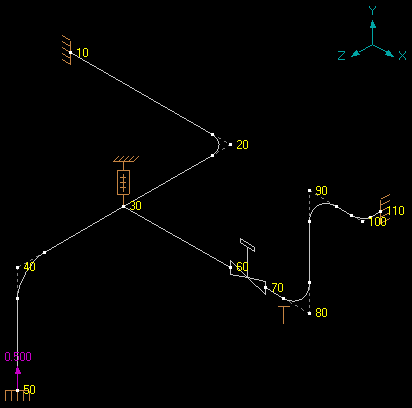
Using Viewpoint in CAEPIPE Graphics
Quite a useful feature in CAEPIPE graphics, Viewpoint can be used to view your model in four fixed ways and in any unique viewpoint you define using the X, Y and Z components.
Most of the time, however, you might work with Isometric view. At the click of a mouse button, however, you can change to X, Y or Z view. Another nifty nuance of this feature is that when you rotate a model and find a viewpoint you like to keep, it is easy to do so. Simply open the Viewpoint dialog after rotating to a view you like, and look at the settings of X, Y and Z components. Then, write them down as a comment line on the layout screen. Now, you can set the viewpoint to those unique settings anytime later. Until you modify the viewpoint, the last used one is saved with the model (make sure to save the model because that alone saves the settings).
Click on a button (X view, Y view, Z view, Isometric) to change the view, or type in the fields for X, Y and Z. The Sample model is shown below in the 3 views (X, Y and Z).
